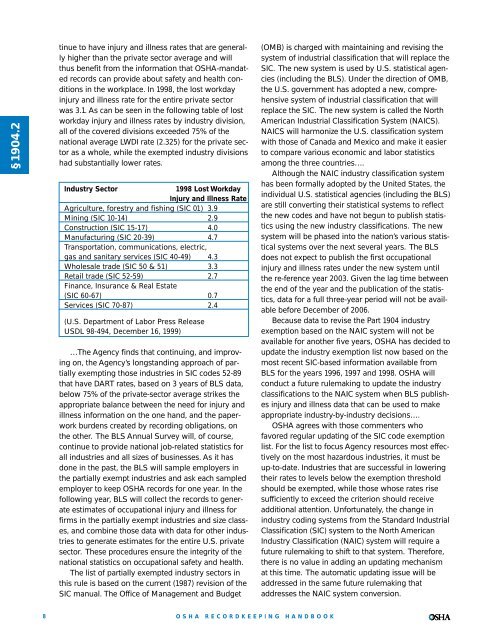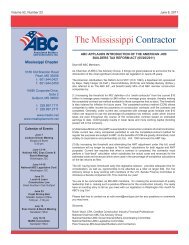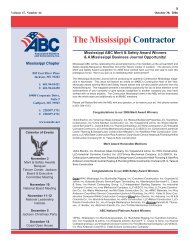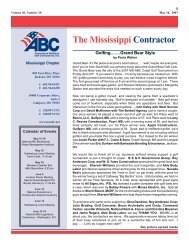OSHA Recordkeeping Handbook - Msabc.net
OSHA Recordkeeping Handbook - Msabc.net
OSHA Recordkeeping Handbook - Msabc.net
You also want an ePaper? Increase the reach of your titles
YUMPU automatically turns print PDFs into web optimized ePapers that Google loves.
§1904.2tinue to have injury and illness rates that are generallyhigher than the private sector average and willthus benefit from the information that <strong>OSHA</strong>-mandatedrecords can provide about safety and health conditionsin the workplace. In 1998, the lost workdayinjury and illness rate for the entire private sectorwas 3.1. As can be seen in the following table of lostworkday injury and illness rates by industry division,all of the covered divisions exceeded 75% of thenational average LWDI rate (2.325) for the private sectoras a whole, while the exempted industry divisionshad substantially lower rates.Industry Sector1998 Lost WorkdayInjury and Illness RateAgriculture, forestry and fishing (SIC 01) 3.9Mining (SIC 10-14) 2.9Construction (SIC 15-17) 4.0Manufacturing (SIC 20-39) 4.7Transportation, communications, electric,gas and sanitary services (SIC 40-49) 4.3Wholesale trade (SIC 50 & 51) 3.3Retail trade (SIC 52-59) 2.7Finance, Insurance & Real Estate(SIC 60-67) 0.7Services (SIC 70-87) 2.4(U.S. Department of Labor Press ReleaseUSDL 98-494, December 16, 1999)…The Agency finds that continuing, and improvingon, the Agency’s longstanding approach of partiallyexempting those industries in SIC codes 52-89that have DART rates, based on 3 years of BLS data,below 75% of the private-sector average strikes theappropriate balance between the need for injury andillness information on the one hand, and the paperworkburdens created by recording obligations, onthe other. The BLS Annual Survey will, of course,continue to provide national job-related statistics forall industries and all sizes of businesses. As it hasdone in the past, the BLS will sample employers inthe partially exempt industries and ask each sampledemployer to keep <strong>OSHA</strong> records for one year. In thefollowing year, BLS will collect the records to generateestimates of occupational injury and illness forfirms in the partially exempt industries and size classes,and combine those data with data for other industriesto generate estimates for the entire U.S. privatesector. These procedures ensure the integrity of thenational statistics on occupational safety and health.The list of partially exempted industry sectors inthis rule is based on the current (1987) revision of theSIC manual. The Office of Management and Budget(OMB) is charged with maintaining and revising thesystem of industrial classification that will replace theSIC. The new system is used by U.S. statistical agencies(including the BLS). Under the direction of OMB,the U.S. government has adopted a new, comprehensivesystem of industrial classification that willreplace the SIC. The new system is called the NorthAmerican Industrial Classification System (NAICS).NAICS will harmonize the U.S. classification systemwith those of Canada and Mexico and make it easierto compare various economic and labor statisticsamong the three countries….Although the NAIC industry classification systemhas been formally adopted by the United States, theindividual U.S. statistical agencies (including the BLS)are still converting their statistical systems to reflectthe new codes and have not begun to publish statisticsusing the new industry classifications. The newsystem will be phased into the nation’s various statisticalsystems over the next several years. The BLSdoes not expect to publish the first occupationalinjury and illness rates under the new system untilthe re-ference year 2003. Given the lag time betweenthe end of the year and the publication of the statistics,data for a full three-year period will not be availablebefore December of 2006.Because data to revise the Part 1904 industryexemption based on the NAIC system will not beavailable for another five years, <strong>OSHA</strong> has decided toupdate the industry exemption list now based on themost recent SIC-based information available fromBLS for the years 1996, 1997 and 1998. <strong>OSHA</strong> willconduct a future rulemaking to update the industryclassifications to the NAIC system when BLS publishesinjury and illness data that can be used to makeappropriate industry-by-industry decisions….<strong>OSHA</strong> agrees with those commenters whofavored regular updating of the SIC code exemptionlist. For the list to focus Agency resources most effectivelyon the most hazardous industries, it must beup-to-date. Industries that are successful in loweringtheir rates to levels below the exemption thresholdshould be exempted, while those whose rates risesufficiently to exceed the criterion should receiveadditional attention. Unfortunately, the change inindustry coding systems from the Standard IndustrialClassification (SIC) system to the North AmericanIndustry Classification (NAIC) system will require afuture rulemaking to shift to that system. Therefore,there is no value in adding an updating mechanismat this time. The automatic updating issue will beaddressed in the same future rulemaking thataddresses the NAIC system conversion.8<strong>OSHA</strong> RECORDKEEPINGHANDBOOK







